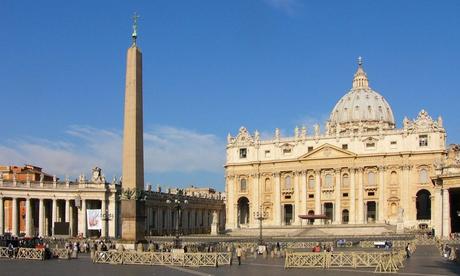
St. Peter’s Basilica
St. Peter’s Basilica was built on top a 4th-century church that is said to rest on the burial grounds of St. Peter himself, the first ever Pope and most loyal disciple to Jesus. The basilica may be the most recognisable attraction in Rome and is one of the world’s biggest churches, able to hold a capacity of 60,000 people. The basilica that we see today has its origins from the 15th century after the previous church had to be completely removed as it fell into a state of disrepair. Even if you aren’t religiously inclined, the basilica should be added to your Rome itinerary solely based on the glorious architecture that can be viewed here. Climb the 491 stairs to the dome of the basilica, the tallest in the world, completed by Michelangelo in 1546, or marvel at Bernini’s baldachin, located in the center of the church. A bronze canopy over the site of St. Peter’s grave, above it an altar that can only be used by the Pope. So, what else should you see near St. Peter’s Basilica that aren’t as highly talked about as the rest of the museum?
Vatican Egyptian Obelisk
You may notice that at the center of St. Peter’s Basilica, there’s a vertical statue 25 metres tall. It’s an ancient Egyptian Obelisk brought to Rome in 37BC by Emperor Caligula however, it isn’t the only one in the city. There were 13 in Rome, meaning that there is more in the Eternal City than in Egypt. What makes the one standing in the Vatican special is that it is the only one standing since ancient times, and as it was originally built to be placed in Heliopolis, northeast of Cairo in Egypt, the age of the obelisk is around 4000 years old. The Obelisk was moved in front of St. Peter’s Basilica in the 1500s by Pope Sixtus V as a symbol of the Church’s triumphant win over heresy and the obelisk is said to carry relics of the true cross of Jesus Christ.
Pinacoteca
Before 1932, there was an influx of art that continuously moved around the Vatican in different exhibitions, not really having a home. Thus, the project began of constructing the Pinacoteca, an art gallery that could hold the Pope’s very own art collection. The only requirements were that it had to have good lighting so that the art could be presented but not in a way in which the artwork would not be damaged.
A tour of the Pinacoteca should take about 45-90 minutes as you make your way through the 18 rooms that hold 460 paintings from the current and past Pope’s private collection. The artwork spans from the 12th century to the 19th century and features masterpieces from Giotto and Leonardo Da Vinci. One of the most popular pieces is that of Raphael’s ‘Transfiguration’, the last artwork he began before his death, that was finished by one of his pupils after his death.
Vatican Necropolis
One of the Vatican’s best keep secret is located 5 floors down from the Vatican Museums, in fact, it’s so hidden that only 250 people can visit a day, with a maximum of 12 people in a group. You’ll need to get special access to see this area as well as book a guided tour of where archaeologists have excavated. The area, which is 100 metres long and features 22 mausoleums was at one point in history on top of Vatican Hill, where the Basilica stands today and was only discovered in the 1940s.
So, what makes this area so special? The Necropolis is a burial ground that holds the tombs of Christians and Pagans dating back to the time of the beginning of the Roman Empire. A level above the Necropolis and you’ll find the Vatican Grottoes, where both Kings and Queens are entombed. Only 3 women have been buried there. The Necropolis is said to house the remains of St. Peter, as a grave was found with the inscription ‘Petros Ini’ on it, translating to; Peter Is Here.
Vatican Gardens
In a tradition started by Pope Nicholas III in 1279 to offer a sanctuary and place to meditate for future Popes, the Vatican Gardens had humble beginnings as a single orchard, lawn and garden area. He also had a keen interest on the properties of medicinal herbs, making it the first large scale one of its kind, with rare plants from Yemen, China and the Himalayans. Now, the gardens take up about 23 hectares of the Vatican City’s 44 hectares. The gardens as we see them today have a fascinating history that begins sometime in the 16th century when famed architect Bramante draws up plans for a new garden that features three styles. The first is an Italian style garden that is formal and in a renaissance setting. The second is a French-style garden with baroque features and statues, whilst the English Garden has many artificial caves and temples.
You may only tour the gardens with a guide who will take you to the most notable attractions in the area such as the Stemma Papale, the papal coat of arms outside of the Palazzo del governatorato which changes for each Pope. The current papal coat of arms is a myriad of yellow, red and purple flowers for Pope Francis. Visiting the gardens are a great way to get away from the hustle and bustle of tourists that crowd the Vatican Museums to have some much-needed relaxation time. While you’re there make sure to check out one of the more unusual pieces in the gardens; a fragment of the Berlin Wall.

